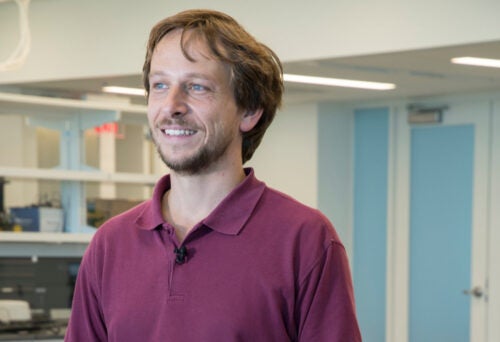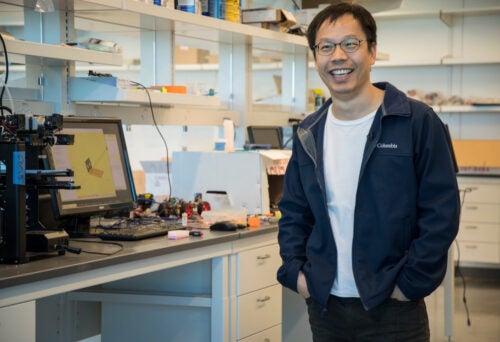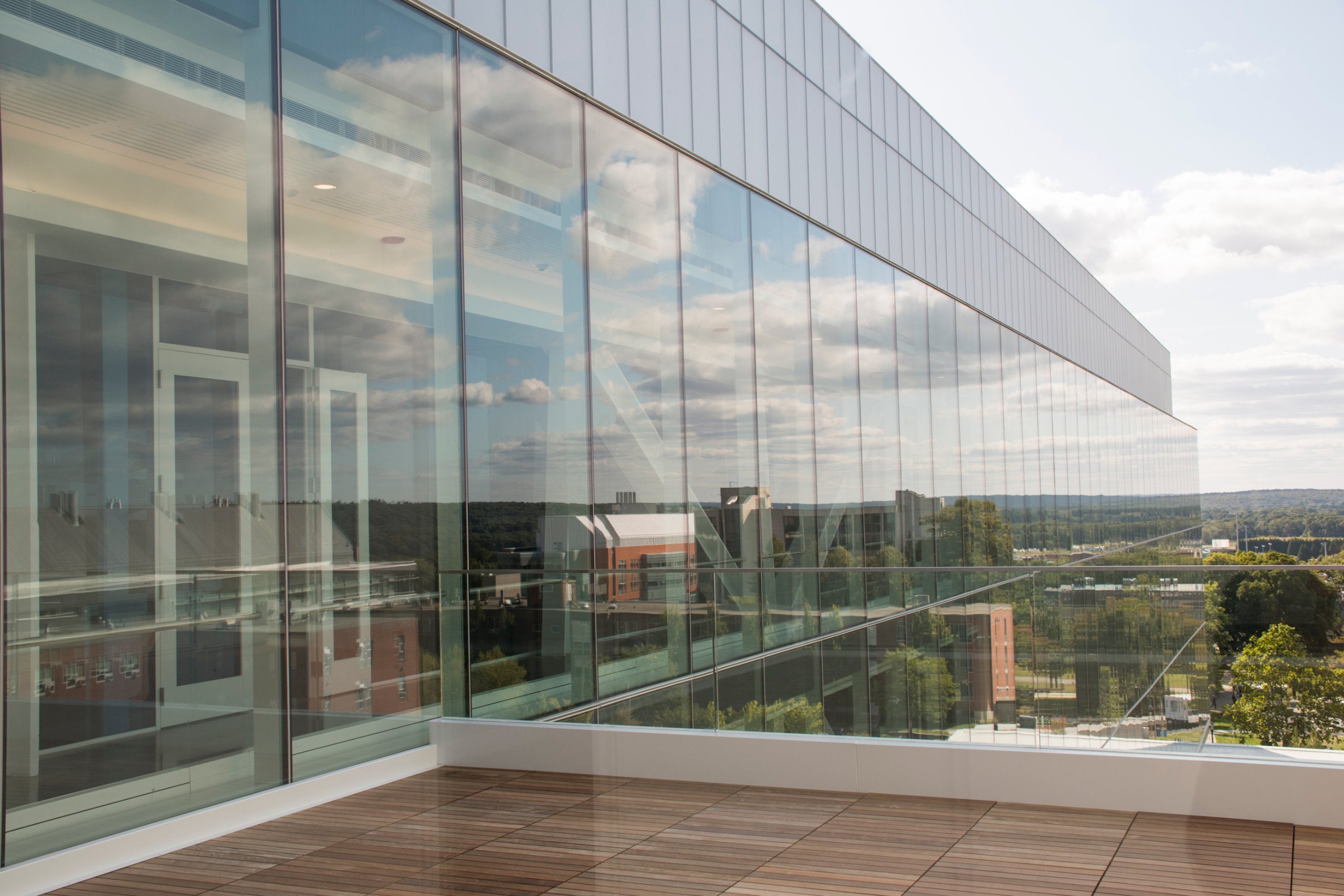Engineering student Robin Hall ’20 demonstrates his drone project, using an existing design from the lab.
(University safety guidelines regarding photography and videography adhere to directives from the Centers for Disease Control and Prevention and Rhode Island Department of Health.
Imagine soft robotic systems that can be used after a natural disaster to locate survivors or enter the places that search and rescue teams can’t reach.
Consider aerial robots able to respond to simple instructions and assist us in our daily work. Or teams of robots that predict and mitigate harmful algae blooms that can threaten our drinking supply or harm wildlife.
In the Intelligent Control and Robotics Lab, Chengzhi Yuan, assistant professor in the Department of Mechanical, Industrial and Systems Engineering and Paolo Stegagno, assistant professor of Electrical, Computer and Biomedical Engineering are working collaboratively across disciplines in the area of robotics to develop these and many other new technologies. Their research is opening up a world of opportunities for students.
The opportunity to do anything
As a senior, Robin Hall ’20 received an independent research grant from the College of Engineering to develop a wall-traversing drone, working with Paolo Stegagno as his grant advisor.
“Working in robotics is like the Wild West in terms of the opportunities it presents. It’s always innovative, always changing, and there is always something new to work on,” said the recent grad. “One of the challenges in creating drones that can tilt and move is finding a way to perform the movement smoothly. They can’t go too far in any one direction.”
Hall’s idea was to employ a four-propeller uncrewed aerial vehicle (UAV) surrounded by an external cage that rotates independently from the internal body of the robot, protecting the vehicle and maintaining stability. His innovation was to fix two axes and add a motor to the third to control its movement. The project, although cut short before the testing phase due to Covid-19, helped Hall develop an advanced knowledge of control systems.
Engineering students, Jacob St.Germain ’21, Heather Rojas ’21, and Nicholas Diluiso ’21 test a miniature drone they build as part of their senior Capstone project.
Graduate student Thivanka Perera works on the coordination between vehicles in robotic swarms.
Hall, who completed his undergraduate degree during The Fascitelli Center for Advanced Engineering’s first year, noted that the Center’s organization and research facilities increased opportunities for him, including a greater interaction with faculty from different disciplines. “Someone from a different engineering discipline or research area may have a perspective that helps you think about your project in a new way,” he said. “It feels like you have the opportunity to do anything.”
Research that advances what we can do

Stegagno is a co-principal investigator in a multidisciplinary National Science Foundation study that will use multi-robot systems to gather scientific data to monitor harmful algae blooms in freshwater systems. Working with fellow investigators across a broad range of disciplines, Stegagno is developing drones that fly over water and collect data on chlorophyll concentration, oxygen levels, and vegetation growth. The study will develop techniques to help public health officials and environmental scientists monitor and protect regional ecosystems.
Students work closely with Stegagno, particularly in the operation of the drone and the data collection. This year, the lab offers two new opportunities for teams of students in their senior year to work on real-world challenges. These are called Capstone Projects. One team in the Robotics Lab is designing a gripper, a hand-like apparatus for a robotic arm. The other team is designing and building a miniature drone.

Chengzhi Yuan’s research focuses on the design, fabrication, monitoring, and control of soft robotic technologies that have the potential to be used in search and rescue, exploration, and surgery. Soft robots can deform their soft bodies to adapt to clustered environments without damage or jamming. “The main challenge with soft robotics is that their dimensions are infinite, so we don’t have a systematic way for control modeling,” says Yuan.
Instead of relying on physical laws, Yuan is exploring ways to use machine learning and large data sets. “It’s an exciting field for students because it is still so new,” he says.
Students work alongside faculty in the Intelligent Control and Robotics Lab designing, operating, and testing UAVs and soft robotic technologies.
Yuan received a grant from the National Science Foundation to develop a unified framework for the design, modeling, and control of soft robots. This project will fill the gaps in knowledge needed to realize new soft robot technologies, in underwater exploration, aerospace, health care, the biomedical field, and agricultural industries. Undergraduates work closely with Ph.D. students, who serve as mentors. The teams have designed and built a small soft robot, capable of caterpillar-like movement. The next step will be to discover new applications for the technology.
As our society begins to address increasingly complex scientific problems, researchers will have to work across traditional areas of specializations and with colleagues from other disciplines. The technologies being developed in the Intelligent Control and Robotics Lab will not only address specific challenges, but they will expand what future generations can achieve.

The Fascitelli Center for Advanced Engineering opened in fall 2019. One of the most technologically advanced facilities in the United States, it is transforming engineering research and education at URI. The research spaces are organized around eight themes: advanced materials and structures, biomedical technology, robotics, clean water for the world, sensors and instrumentation, sustainable energy, nanotechnology, and cybersecurity.
